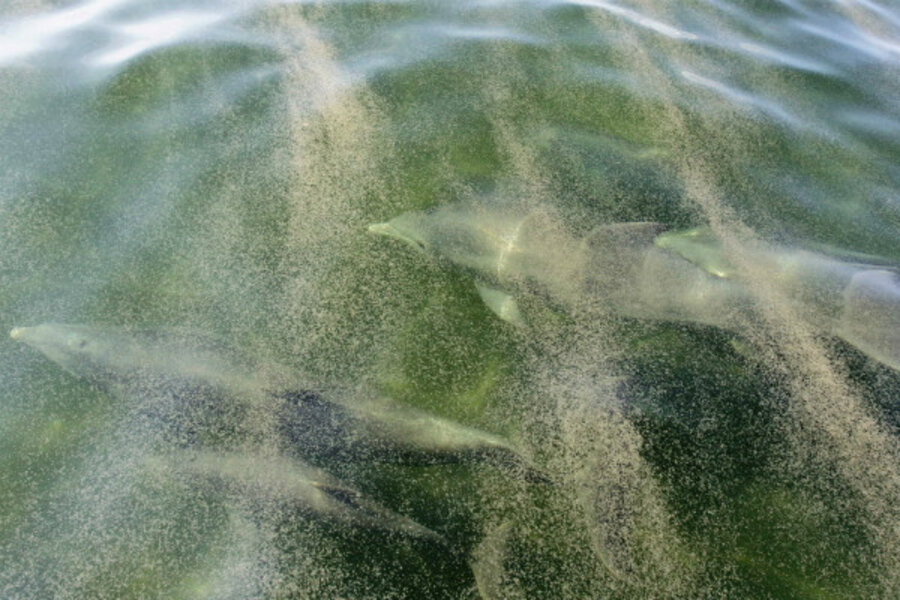Bacteria, cold water, and probably oil killed baby dolphins in Gulf, say scientists
Loading...
| New Orleans
Surges of snowmelt pouring into the Gulf of Mexico may have been a final stress affecting when and where 86 baby dolphins were aborted or died shortly after birth in early 2011, researchers say.
Water temperatures fell in Mobile Bay and Mississippi Sound two to three weeks before each peak in infant dolphin strandings, a new research paper reports.
The cold water may have been the final straw for animals already prone to premature birth for other reasons and probably stressed both by the 2010 oil spill and the unusually cold winters that bracketed it, said Ruth H. Carmichael, senior marine scientist at Alabama's Dauphin Island Sea Lab.
"These freight trains of cold fresh water may have assaulted them, essentially kicking them when they were already down," she said.
It's too early to comment on causes or contributing causes, especially since dolphins are still dying at higher rates than normal, said Teri Rowles, a National Oceanic and Atmospheric Adminstration scientist. She has been studying the deaths of at least 753 dolphins since February 2010 in the northern Gulf of Mexico, where the BP well began spewing oil on April 20, 2010.
"We typically don't come out with a conclusion about contributing factors and causing until it's over and we can sit down and look at all the data and all the analyses together," she said Wednesday.
The one common thread so far has been brucellosis, found in 12 of 51 animals tested so far for Brucella bacteria, she said. At least three of the dolphins which tested positive for the bacteria were adults or subadults, but most were infected while still in the womb.
"They were infected in utero and they died before they took a breath," she said.
Rowles said samples are still being tested to learn whether they are all the same strain or different strains of Brucella.
The deaths started during prolonged cold, when other coastal species also were dying. Though the totals for this past May and June are far below those for the same months in 2010 or 2011, they are still above normal, according to NOAA.
"We're focused on a small portion of that big event," Carmichael said.
Typically, water temperatures in the northern Gulf warm slowly from about 50 degrees to 77 degrees between January and April. But in 2011, the year the scientists looked at the dolphin deaths, there were at least three steep drops in temperature because of the snowmelt entering the Gulf — mostly through the Mississippi River — with temperatures dipping by 10 to 20 degrees over a few days.
During the first four months of 2011, 186 dead dolphins, almost all of them young, were found from the Florida Panhandle to the Louisiana-Texas state line. The young dolphins included 86 infants less than 45.3 inches long, 61 juveniles and 18 subadults.
The deaths during those four months made up nearly one-quarter of the strandings that NOAA has logged in that area since February 2010. According to NOAA, 114 were before April 30, 2010, 122 were between April 30 and Nov. 3, 2010, and 517 were since Nov. 3, 2010.
The 86 youngest to die early in 2011, classified as "perinatal," are the focus of the study published Wednesday in the online science journal PLoS ONE.
Exposure to oil and other organic pollutants has been linked to perinatal and infant mortality in some marine mammals but has not been reported among dolphins, the study said. Other scientists have found that plankton quickly gobbled up nontoxic carbon from the spilled oil, bringing it into the Gulf of Mexico's food web.
Unpublished data from the University of Southern Mississippi indicates that there may have been less food than usual compared to the number of pregnant females in early 2011, the paper said.
Last fall, Rowles and other researchers reported that Brucella, common bacteria known to cause abortions in marine mammals, had killed two adults and three fetuses out of 21 tested. They could not — and still cannot — say why the germ that had been found in healthy animals and that occasionally killed single animals was apparently causing an animal epidemic.
Carmichael said, "It could have been they were going to abort due to Brucella infection. Some animals are known to abort due to exposure to oil-derived substances. I can't tell you it wasn't one of those two things that caused those animals to have early delivery. But it (the pulses of cold water) may have determined when it happened or where those animals washed up on shore."







